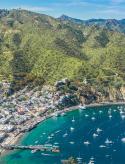Jupiter and Saturn will join in the ‘Great Conjunction of 2020’ on Monday, December 21, the day of the Winter Solstice.
Catalina Island’s dark, clear skies will make for a spectacular view of what some are calling, ‘The Christmas Star’. The two gas giants will shine low in the southwest after sunset, and appear to be separated by 0.1 degrees. By comparison, a full moon is 0.5 degrees – so, about 1/5 the diameter of the moon. Jupiter is the brighter of the two.
Although they will not look like one ‘star’ to the naked eye, they will be visible in the same field of view in an average celestial telescope. It will be a rare sight to see Jupiter’s 4 Galilean moons stretched out on either side of the planet, and Saturn’s rings in the same field of view.
The two giants appeared this close on July 16, 1623 - 397 years ago - but were not visible to northern latitudes due to the glare of the sun and low altitude. Before that, it was 794 years ago, in 1226, that they were this close together and seen all over the world. In reality, Jupiter is about 480 million miles from the sun while Saturn is about 900 million miles from the sun – not close at all.
To ancient observers, Jupiter and Saturn were the slowest moving of the five ‘naked eye’ planets, taking 12 years and 29.5 years respectively to make one lap through all the zodiac constellations along the ‘ecliptic’ - which is the apparent path of the sun among the stars through the year. Remember, they did not think of it as the planets taking those years to orbit the sun – their view was that everything orbited Earth. They tracked all the planets’ movements against the backdrop of the constellations.
And they would have known that Jupiter and Saturn were not stars. In fact the word planet comes from the ancient word ‘wanderer’, while the word star comes from the word ‘fixed’. Although both seen as mysterious, ethereal lights in the sky that were not made of the natural elements – earth, wind, fire & water – they behaved very differently from each other.
Stars were ‘fixed’ in constellations moving as a group across the sky and staying in the same place in relation to all the other stars and constellations. Planets, on the other hand, ‘wandered’ along the constellations of the ecliptic – ‘visiting’ each one. Since there are 12, Jupiter visited each zodiac sign, slowly moving across it for about a year (since it has a 12 year orbit).
Interestingly, what ancients would have considered quite unique was a series of conjunctions between Jupiter and Saturn in 7 BC. In that year Jupiter and Saturn met not once, but three times (in May, September and December). Knowing the importance of the movement of the planets amongst the constellations to the ancients, the theory is that this could have started the Magi on their journey to Harod..
So, bundle up, find a high spot and enjoy this rare celestial event on the longest night of the year. Sunset is at 4:50pm. Jupiter & Saturn will set southwest 7:55pm – but if you are down on the flats in Avalon, plan for them to disappear about ½ hour sooner. For those not on Catalina Island, Jupiter is so bright, it is usually visible even in bright cities, but to see Saturn, and really enjoy this, stargazers should seek a dark sky location away from city lights.


